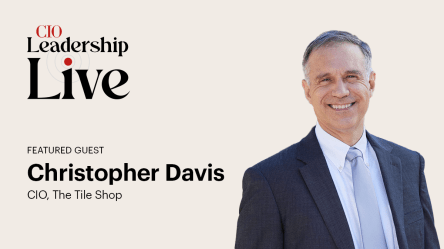TruStone tech execs share AI-driven credit union transformation
Overview
At the CIO 100 event, host Lucas Mearian sat down with TruStone’s Gary Jeter and Mayka Thao to discuss post-merger modernization, mobile innovations, and generative-AI tools enhancing efficiency.
https://www.linkedin.com/in/mayka/
https://www.linkedin.com/in/gary-jeter/
https://www.linkedin.com/in/lucasmearian/
Transcript
Welcome to CIO leadership Live. My name is Lucas Mearian. I'm a senior writer with Computer World Magazine.
I'm at the CIO 100 symposium and award show right here in Scottsdale, Arizona, and today I have with me Gary Jeter, he's the Chief Technology Officer and Mayka Thao Vice President of IT development and Global Planning and Delivery at TruStone Financial Credit Union out of Minnesota.
Thank you so much for being here. I really appreciate it taking the time to talk about this. About four years ago, your credit union merged with Firefly, another credit union.
Can you talk a little bit about how that's affected your technology roadmap, how it's evolved, and how did you integrate the two systems?
Yeah, I can start. So make a was the overall integration leader. I was the champion as far as both of us came from the Firefly side. So it was a merger of equals, and at the time, it was the largest merger of equals in credit unions.
At that time, they're bigger than that.
There's been a few bigger ones since, yeah, we took it from the approach of Best In Breed as far as the technology, and so spent a long time working with the business as far as which technology suite that we're going to use, and about 60% came from TruStone.
About 40% came from Firefly, I would say. And the core financial platform, we took true stones because fireflies was retiring. It was a but where we were then, where we are today, has changed significantly.
So I would say we were working off of a lot of very legacy systems. We were very point specific solutions, and we really didn't have an enterprise architecture function. So we've done things like improved overall security. We've only Firefly had a data team, true Stone did not.
So we've come in with a overall data strategy to really make that happen. We've looked at as far as bringing in a I PaaS, system integration platform as a service.
So we brought in developers to be able to serve as that master integrator and reusable connectors across the board, and we've looked at cloud strategy, so we've migrated our core financial platform to a private cloud, and that's been greatly successful.
So we're on a journey to modernize our architecture, and it's all about speed, speed, speed, right? To be able to keep up with just the massive changes within within technology and AI.
Well, that kind of leads me to my next question, and then it has to do with your mobile app, which has received some praise. I went online and looked at it, and it's got some pretty high praise from from users of it.
Can you talk a little bit about some of the next major improvements to that? Are there new features you have in store for the future pipeline?
Yeah, making you want to take it or you want me to, yeah, I can add on top. Okay, yeah. So we, we, you know, digital banking is huge, right?
You think of the number of members we have, probably 55% of our members now are using digital banking as their as their primary platform. So, yeah, we've added, we have a great roadmap. In fact, next week, knock on wood, we're gonna be launching card controls.
So, and it's that's something that's a lot of financial institutions already have, but ours will will really kind of take it to the next levels with different notifications and alerts and across the board.
So that's, that's one, and you know, we were continuing looking at next year, bringing in, integrating our loan origination system, and modernizing that, making that a better experience, removing friction.
You know, the way members are looking at digital banking today, it's, it's really a three minute account, opening a two minute loan. So it's got to be, it's got to bring, bring that type of friction down to be able to make it happen.
We've got a lot of fraud technology in there too. So I don't know, make if you want to add, yeah,
I mean, recently we just integrated. We are fraud solution is within the core.
So we just integrate it, you know, from a digital banking into the core to bring some of those near real time transactions so that our fraud and BSA department can tackle some of those more trending suspicious activities near real time. Yeah, let's
maybe this leading to my next question, which is, are you? Are you considering AI to assist you with fraud and security within those applications?
I would say yes, yes, because, I mean, without, you know, AI driven, it's going to be more in the of the manual, right, kind of waiting for something to happen, and then you chase after i. And so definitely, but have to be the right use case.
Okay, so you haven't piloted anything yet, for
from a security perspective, I don't think,
yeah, so I know our vendor partner leverages a lot of machine learning and things like that to be able to identify fraud. We have on the roadmap, because credit union, we're not huge our BSA fraud team work business hours.
So we're looking at, you know, from an agentic AI perspective, how can we really kind of take it to the next level when we identify these things and react? So that's, that's the use case that make a making team. Are working on her development team? Yeah.
Are you exploring any use cases for generative AI, right now?
Well, today we were using it, yeah. So we're using it for all our policies and procedures, you know, make a can talk about that. She, she led that charge as well. Yeah.
So it's, you know, bringing our knowledge for the frontline staff, you know, putting all of those policies and procedures into a within our solution. And then it's almost like a chat GPT, you know, you prompt it. It gives you the information.
It also ties it right to the original procedure, in case they want to pull it up for, you know, second set of eyes or what you may but the the overall, I would say, results from that was, you know, from 15 minute at the front line waiting for the back office to respond back to an inquiry where maybe the front line member isn't so sure of you know what the right process or steps to proceed, it's gone down to under three minutes.
So wow, or a lot faster. I mean, that's 5x improvement. Yeah, yeah. So, I mean, at the end of the day, it's really providing that member experience where they don't have to wait for a lengthy time and or maybe even have to wait for a call back, right?
Because, of course, you can't be holding a member at the station for that amount of time. So yeah, from from the member experience, it has improved from an employee experience.
Adoption was huge because, I mean, being that first gen AI tool, there's a lot of, I would say the adoption of trusting a new AI tool, we had to do a lot of focus group really learning how we can help our employees to adopt to it.
So it was a journey. But, you know, we chunk it down and we we did some proof of value and concept, and then really gain that trust of our employees before we do a full bang, bang launch.
So I've got so many questions in my head. Yeah, data cleansing, you know, making sure your data was prepared for artificial intelligence. Can you talk a little bit about that? What were the challenges there?
Do you want to Yeah, I can, I can. I can take a shot at that, yeah. So make us being a little modest, right? So we actually, we actually started in October and deployed by February.
And we took a novel approach, was, we're not going to worry about data accuracy all these policies and procedures, if an employee went to the internet or internet, I mean, some of those policies were dated in 2019, they were just out of date.
So we put all 600 plus policies into the repository, let the large language model churn through it, and then we created basically an individual so as a thumbs down happened, that person would go and work with the business process owner to update the policy.
And the nice thing, as soon as he dropped it in, replaced it near real time. Now the accurate information is out there and so and like make, I said, we started with a proof of value, moved to a proof of concept, so 1010, employees, to about 50 employees.
And then we went to a region which was about 200 employees, 8080, employees. And during that time, we started a 23% data quality, we got it to about 75% data quality over those those few months, from thumbs up, thumbs down, and then we launched it.
Rather than waiting for perfection, we just got it out there, and now it's sitting at about 92% data quality. Wow, so and it just saves so much time for members. We've eliminated all the policies and procedures off the internet.
That's the only place they go to to do it. And it's just like, in a big head
AI has forced this, but you wish you'd done it years ago. Yes,
Yeah, it just never got around. Yeah. That's a lot to deal with Yeah. So it's really, it's really cool. Yeah, it's. So other use cases we're doing, we're looking at using a large language model to crawl our website.
So our chat bot would you know, if you asked what the interest rates are, those change right? The it would crawl, it identified and be able to respond to it. We're getting ready to launch that so you think of more of a traditional chat bot, rules based.
Type thing still uses machine learning for intent based but now, how do we we're, we're looking at launching an LLM type chat bot, yeah.
How's it been trying to bring the organization along with the changes that AI bring? That's hard. That's got to be a challenge. Hard, yeah. How do you do it. I do educate. Is it about upskilling? Is it about policy, new policies, or how do you do it?
So you want me to go first? Yeah, okay, well, so sorry, but yeah, we started with Board education and the EVPs, right? So came in explained. You know what a large language model is how it worked across the board.
And really, from from that we was, was one of the Start aspects of it.
Now, you know, through a series of steps, we evolved to now we have a Gen AI class, which employees sign up for, and it's become the number one class across you know that that employees are taking the other thing is we, we have a good data loss prevention platform.
So we, we went ahead and opened up chat, GPT, Gemini notebook, LM, as well as thought, AI to to our employees to be able to use it, and created a policy around that, as far as what they could put into it, what they can't.
And then we have monitoring and observations to make sure they don't put any PII or, you know, information. But we're evolving. We're we're really looking at, how do we double down on it? But other change management type thing.
Yeah, I was gonna say we also launch a digital maturity assessment to really assess our current state and really leaning on to our executive leaders to help us build that future. Where do we want to get to?
So with that, the outcome of that was, you know, pinpoint some of those larger variation, as far as where we are today, and work on some of those key competencies to get our employees to get closer to that North Star.
So for example, some of those focus areas were like technology, right from an integration perspective, like, how far are we? Are we still very legacy platform?
Or are we modernizing our our systems and then to, like, even the learning piece, where it helped introduce these Gen AI courses to help educate our employees.
So there's Yeah, little steps there to get us to be a little bit more mature from a transformation perspective, yeah, sure, yeah.
Well, other than healthcare, financial services has got to be the most highly regulated vertical industry out there. Can you talk a little bit about, especially from a perspective of rolling out artificial intelligence? How do you deal with the regulatory issues, the security and the privacy?
What are some of the challenges there?
There's, there's a number of challenges, right? And a lot of it has, some of it has to do with organizational, change management, cybersecurity type aspect, as far as you know, what you know, what data do we allow into the model? How do we maintain it?
Whether it's on prem or own private cloud. So it's, it's, there's a lot out there, yeah, so it's really kind of stepping into it. Yeah, we're kind of, yeah.
I read an article.
I can't remember what it is, but I think everybody struggles with that, because, from a regulatory perspective, is, you know, they can understand the input of data going in and the output of it, but what's happening between that black box, that's the part where people, you can't explain that.
So from a regulatory perspective, is they're still really trying to figure out, like, what's happening between that black box? That's an article that I read.
So I think it's, it's not just financial, but I think everybody that's trying to leverage, you know, Gen AI or in that space, is still trying to figure out, how do we set guard rail guardrails or rules, or how do we comply with it?
One other point, so Kyle Kyle Hatfield, who is the chairman of the NCUA, it's kind of like the FDIC. He is very more tech, leaning forward, more progressive. So he's and then Rodney hood as well.
Used to be the former NCUA chairman, so I we're given a license, if you will, to be able to experiment from the regulators and the examiner's perspective. But it's tough, right? It's tough where you hit the line.
And so we work very closely with our legal department, our compliance team, to make sure we're
have your IT partners helped at all with that, your vendor partners?
Yeah, I would say so, yeah. So like, we have a partner or omni channel solution partner, very, very keen on regulation. As far as you know, how you know? How well do you, you know, what? What can you use the chat bot for? How do you communicate members?
How do you send, you know, text, what you're allowed to work through?
So, yeah, I think that's, that's a big aspect with it, you know, sense of AI who we work with, as far as the chat bot for the policies and procedures they're, what's called a CUSO, a credit union service organization, which is a lot of credit unions invest in them.
So they stay very keen to the regulations, compliance type things to again, help us, you know, stay on the right side.
The cost of AI can definitely snowball. And I'm assuming that you're using a cloud service for these AI, unless you you didn't implement it internally Correct. No. How do you reel those in?
Because one of the things that I think a lot of organizations don't understand is every time you offer a prompt, every time you get a response, you've got to pay for that. Yeah.
And if employees aren't trained to not ask the exact same questions they're asked, they're trained to ask pointed questions, or you store some of the answers so that you can reuse them, the costs can really get out of control. How have you dealt with the costs?
I mean, with Senso… yeah.
So today we leverage, it's a company called Senso.ai.
They're out of Toronto, Canada, so we have a fixed cost with them, and so as far as policies and procedures, now you bring up a really interesting point as we start looking at where we're doing a kind of a spike out where we're going to build a language talker, right?
So you could talk to your data. Give me a data set that's, you know, members and in Wisconsin that have a balance over x, x, y, and then marketing can get that data out. We have not figured out the cost thing yet.
So we're, we're that's going to be a big aspect of it.
You're not alone, yeah,
that part, but the proof of concept will step into it, learn from it, and then we'll look at, you know, how do we, you know? How do we judge it from there, sure, Skills gaps.
Are you seeing them? And what are the biggest skills gaps you're dealing with?
Now, I'll say this, there was a time when a computer science degree was truly valued, and today I'm hearing from a lot of executives they want more of the soft skill sets, the certifications and some of those are lacking, especially when it comes to artificial intelligence and some of the newer technologies.
Have you? Have you been struggling with that at all, getting some soft skill potential into your company?
I mean, from my perspective, no, not at this point. So I know make his team uses plot, you know, essentially cursor for for development, and that's been super helpful. So I think it's just sped up things relative to this area.
Now, could there be a skills gap in the future? Absolutely, but we don't have enough developers. We don't have, you know. So it's not, we don't have enough, you know, within it. So if anything, this is just going to make folks jobs easier. Okay, that's, that's how we're
I've heard that as well. Have you been using AI assisted development at all software development? Or is it called jive? Jive development? Or, yeah,
no, not Yeah, not jive. But, I mean, to Gary's point, we've tried using other AI tool, like, you know, cursor, trying to have the development team explore, Hey, what are some of those AI tools that we can use to help us develop a bit faster? Yeah, yeah.
We just had a developer go to a hackathon that essentially leverage the Gemini API to build a fraud detection bot for and again, that was what, two days, three days over a weekend. It's not ready for production, but it just showed you the art of the possible.
And how quickly those things can be built. And you know how, how prompting can help that? Yeah, yeah.
What I've heard from people who use it, it takes care of the grunt work so that you can be more creative. Yeah, yeah. Okay, fun question, okay, what's your favorite tech gadget or app right now? And it can be personal or professional.
Yeah, you want to go my,
my favorite is actually chat GPT, the voice. So I'll, I'll drive to work. I'll get that voice talking to chat GPT. And like, you know, hey, you know, tell me about digital assets. You know what's going on in that space.
Tell me you know the genius act, you know, give me more information. So, I mean, as far as preparing for things and, like, help me plan my day here. So it's like a brainstorming companion on my very unjoyful commute.
So that's, that's, that's the thing that I'm really having a lot of fun for, yeah, yeah,
for me, is notebook. LM, notebook, LM, yes. I use it for deep research. I use it to, like, you know, big articles, or where I can just feed it in and then give me, you know, a one pager summary.
Yeah, that that white paper, so to speak, so that that's been helpful.
I familiar with notebook LM,
I'm not and you use chatg, BT to give me summaries of long reports, yeah?
Notebook, LM, you can make a podcast, yeah, okay, out of a, like, a document, yeah? It's like, so if you wanted to consume a document, it makes it into a podcast. It has two, you know, I guess avatars that are talking back and forth. It works brilliantly. Yeah?
Notebook, elemental note, yeah, it's Google. It's Google. Totally okay. I'm gonna have to, I'm gonna check that out. Look, thank you so very much for taking the time today. I know you've got a lot of stuff going on.
I hope you enjoy this event, and we really appreciate all your insights into the AI and other technology. Yeah, it's great.
Yeah. Thank you so much for having us. Yeah.








